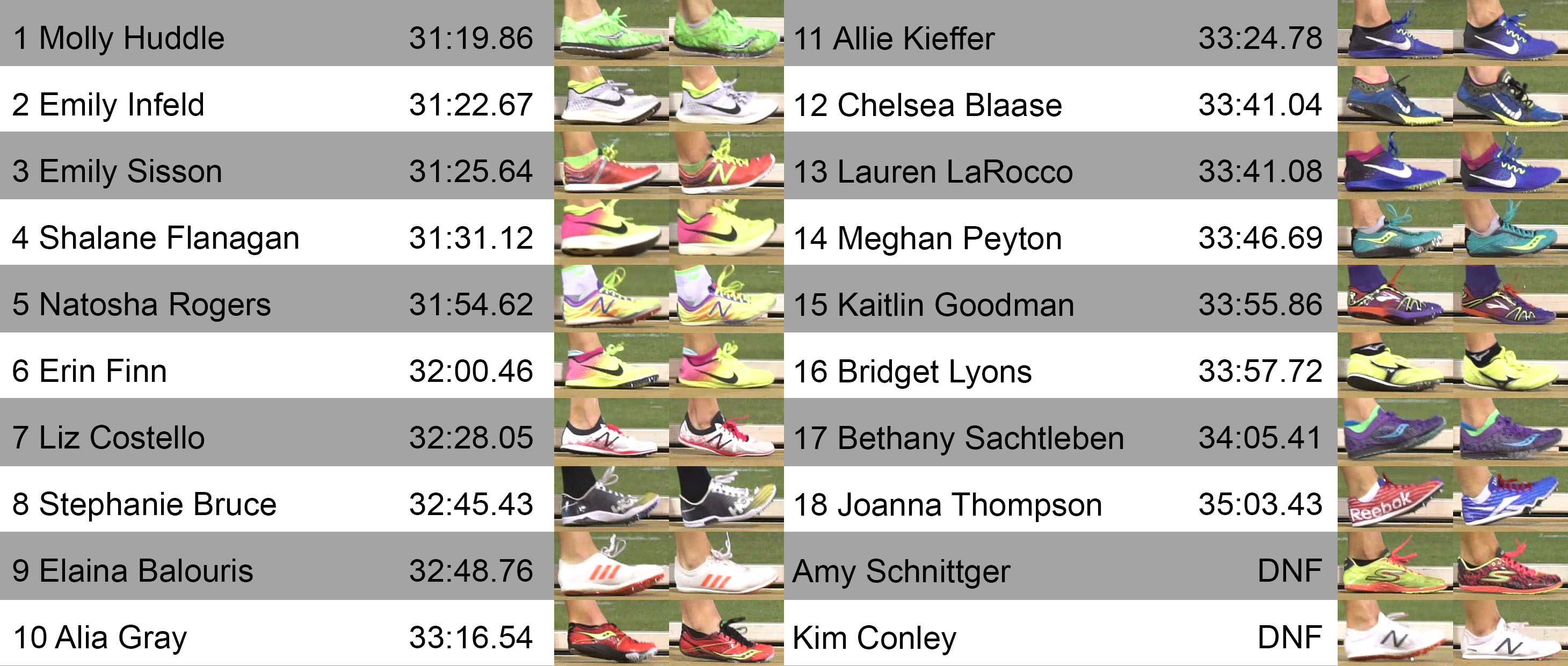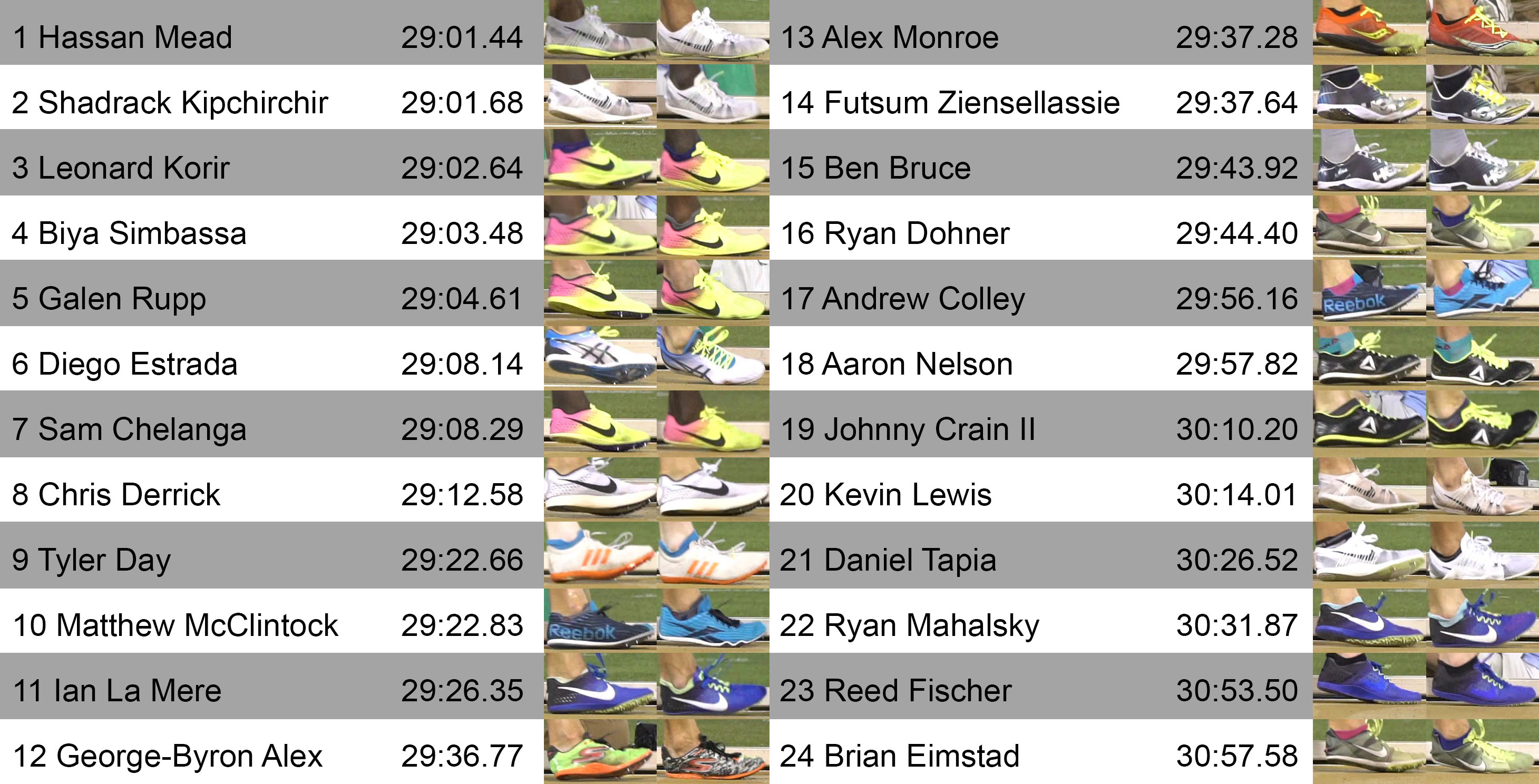2017 USATF 10k Footstrikes
Women's Race

Men's Race

What is generally known from research studies
- Most people progress from heel to midfoot strike as running speed increases
- Some people prefer midfoot or heel striking no matter what the running speed
- Heel strikers exhibit a peak force of about 3-4% higher and spend more time on the ground
- Heel strikers have a longer stride
- When people consciously change from one foot strike to another, stresses on body vary. Runners should be careful during this transition period to avoid injury.
- Most studies show the total incidence of injury is no different between foot strike types, but the locations of injury vary. Other studies say heel strikers have a greater injury incidence.
- Heel strikers tend to become injured more at the knee and hip
- Midfoot and forefoot strikers tend to get injured more at the foot and ankle
- Modifying footstrike type has sometimes benefitted runners in recovering from injury by changes where stresses on the body are placed
- Performance is not different between footstrike types
- Some thought of midfoot being a better approach has often been considered, but it is likely just because faster running tends to lead to a midfoot strike.
- If someone forces an unnatural footstrike at slower speeds, they will likely use more energy to run
- Footwear often affects footstrike type since a minimally padded shoe or barefoot running make it too painful to land firmly on the heel
- Running with a moderately cushioned lightweight shoe uses the least amount of energy leading to improved performance.
Research Articles
- Franz JR, Wierzbinski CM, & Kram R (2012). Metabolic cost of running barefoot versus shod: Is lighter better?, Medicine and Science in Sports and Exercise, Vol 44, p. 1519-1525.
- Allison H. Gruber, Brian R. Umberger, Barry Braun, Joseph Hamill (2013). Economy and rate of carbohydrate oxidation during running with rearfoot and forefoot strike patterns, Journal of Applied Physiology, Vol 115, p. 194-201.
- Hasegawa H, Yamauchi T, Kraemer, WJ (2007). Foot strike patterns of runners at the 15-km point during an elite-level half marathon, Journal of Strength and Conditioning Research, Vol 21, p. 888-893.
- Daoud A et al. (2012). Foot strike and injury rates in endurance runners: A retrospective study, Medicine and Science in Sports and Exercise, Vol 44, p. 1325–1334
- Higgins E et al.(2011). Foot strike patterns of recreational and sub-elite runners in a long-distance road race, Journal of Sports Sciences, Vol 29, p. 1665-1673.
- Goss DL, Gross MT (2012). A Review of Mechanics and Injury Trends Among Various Running Styles, Defense Technical Information Center.
- Samaan CD, Rainbow MJ, Davis IS. Reduction in ground reaction force variables with instructed barefoot running. J Sport Health Sci. 2014; 3: 143– 151.
- Kulmala AP et al. (2013). Forefoot strikers exhibit lower running-induced knee loading than rearfoot strikers, Medicine and Science in Sports and Exercise, Vol 45, p. 2306-2313.
- Forrester SE (2015). The effect of running velocity on footstrike angle – A curve-clustering approach, Gait and Posture, Vol 41, p. 26-32.
- Lyght M et al. (2016). Effects of Foot Strike and Step Frequency on Achilles Tendon Stress During Running, Journal of Applied Biomechanics, Vol 32, p. 365-372.
- Ogueta-Alday A, Rodríguez-Marroyo JA, & García-López J. (2014). Rearfoot striking runners are more economical than midfoot strikers, Medicine and Science in Sports and Exercise, Vol 46, p. 580-585.
Thoughts about these images
- There is a wide variation of foot strikes among the top US 10k runners
- Some extreme positions are found in these elite runners. Some of these runners have very little injury history.
- The women's race this year is very scattered supporting studies that show foot strike is not related to performance across individuals
- The men's race has midfoot strikers closer to the front and rearfoot strikers towards the back. This may be due to the faster speeds most of the midfoot strikers were running. When running slower, most of the runners might be rearfoot strikers.


